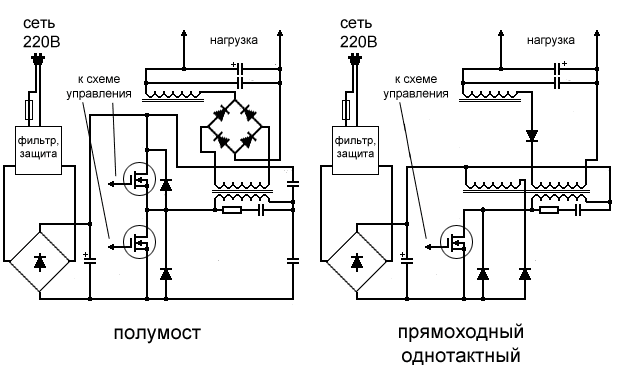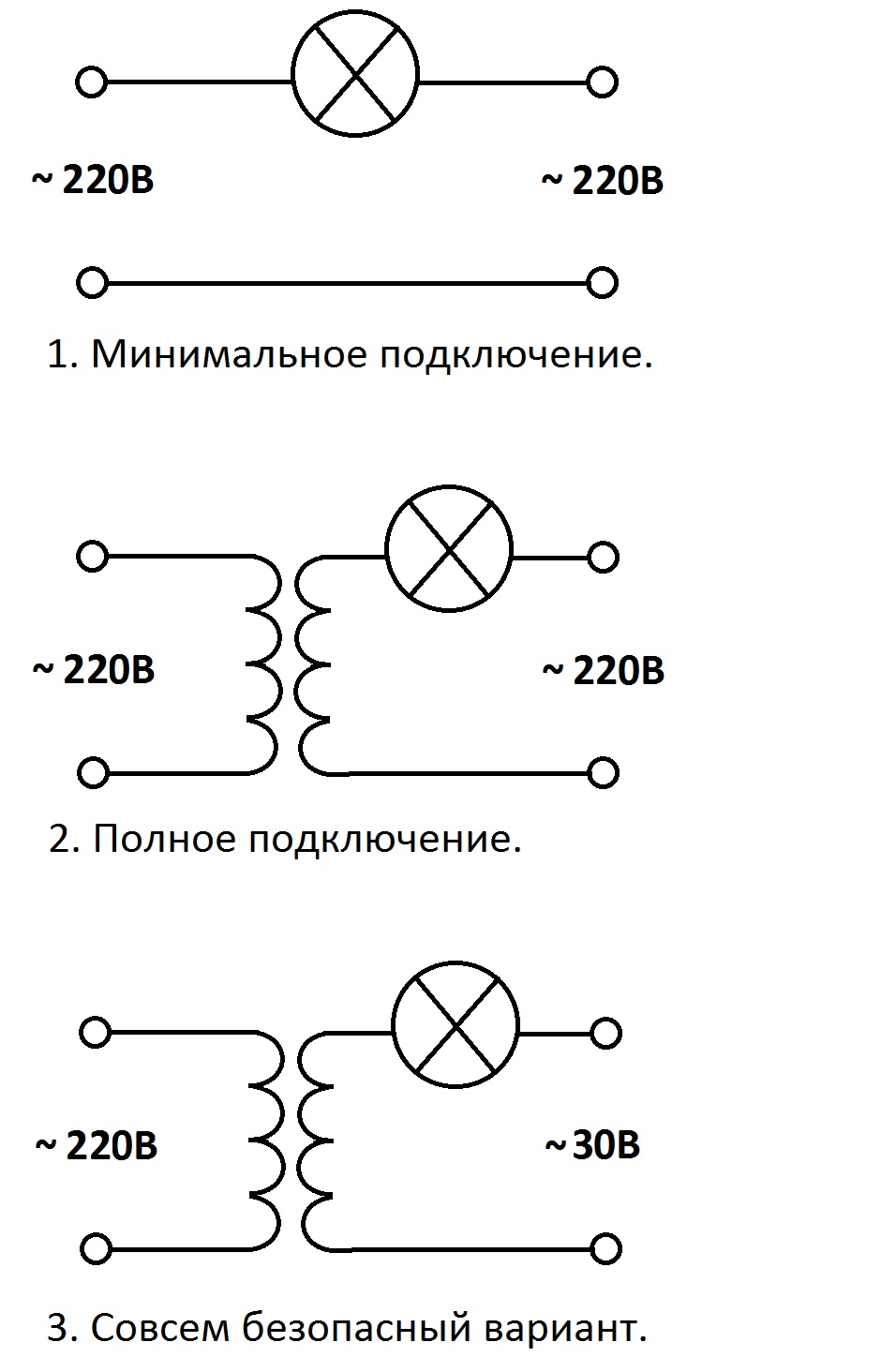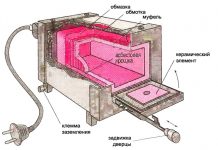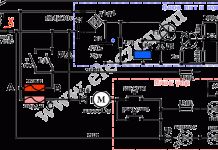In detail: DIY repair switching power supplies from a real master for the site my.housecope.com.
Authors: Baza, NMD, plohish, mikkey, VOvan, NiTr0, ezhik97, inch, Mr. Barbara.
Editing: Mazayac.
Important links that have become difficult to find:
-
There is no better book on the principles of BP operation. Read to everyone! Power supplies for system modules such as IBM PC-XT / AT.
What is desirable to have to check the power supply.
a. - any tester (multimeter).
b. - bulbs: 220 volts 60 - 100 watts and 6.3 volts 0.3 amperes.
v. - soldering iron, oscilloscope, solder suction.
d. - magnifying glass, toothpicks, cotton swabs, industrial alcohol.
The safest and most convenient way to connect the repaired unit to the network is through an isolation transformer 220v - 220v.
It is easy to make such a transformer from 2 TAN55 or TS-180 (from lamp b / w TVs). The anode secondary windings are simply connected appropriately, there is no need to rewind anything. The remaining filament windings can be used to build an adjustable power supply.
The power of such a source is quite sufficient for debugging and initial testing and provides a lot of convenience:
- electrical safety
- the ability to connect the earths of the hot and cold parts of the block with a single wire, which is convenient for recording oscillograms.
- we put on the biscuit switch - we get the ability to stepwise change the voltage.
Also, for convenience, you can bypass the + 310V circuits with a 75K-100K resistor with a power of 2 - 4W - when turned off, the input capacitors are discharged faster.
If the board is removed from the unit, check for any metal objects of any kind underneath. In no case, DO NOT CUT HANDS into the board and DO NOT TOUCH the heatsinks while the unit is operating, and after turning off, wait about a minute for the capacitors to discharge. The radiator of power transistors can have 300 or more volts, it is not always isolated from the block circuit!
| Video (click to play). |
Principles of voltage measurement inside the block.
Please note that the ground from the board is fed to the PSU case through the conductors near the holes for the fastening screws.
To measure voltages in the high-voltage ("hot") part of the unit (on power transistors, in the duty room), a common wire is required - this is a minus of the diode bridge and input capacitors. With respect to this wire, everything is measured only in the hot part, where the maximum voltage is 300 volts. Measurements are preferably carried out with one hand.
In the low-voltage ("cold") part of the power supply unit, everything is simpler, the maximum voltage does not exceed 25 volts. For convenience, you can solder wires to the test points, it is especially convenient to solder the wire to the ground.
Checking resistors.
If the denomination (colored stripes) is still readable, we replace it with new ones with a deviation no worse than the original (for most - 5%, for low-resistance current sensor circuits it can be 0.25%). If the coating with the marking has darkened or crumbled from overheating, we measure the resistance with a multimeter. If the resistance is zero or infinity, the resistor is most likely defective and to determine its value, a schematic diagram of the power supply or the study of typical switching circuits will be required.
Diode test.
If the multimeter has a diode voltage drop measurement mode, it can be checked without unsoldering. The drop should be from 0.02 to 0.7 V. If the drop is zero or so (up to 0.005), we solder the assembly and check. If the readings are the same, the diode is broken. If the device does not have this function, set the device to measure resistance (usually the limit is 20 kOhm). Then, in the forward direction, a serviceable Schottky diode will have a resistance of the order of one to two kilo-ohms, and a conventional silicon one - of the order of three to six. In the opposite direction, the resistance is equal to infinity.
To check the power supply, you can and should collect the load.
An example of successful execution can be found here.
Pinout of the ATX 24 pin connector, with OOS conductors on the main channels - + 3.3V; + 5V; + 12V.
You can first turn on the power supply unit to the network in order to determine the diagnosis: there is no duty officer (there is a problem with the duty room, or a short circuit in the power unit), there is a duty room, but there is no start (problem with buildup or PWM), the power supply goes into protection (most often - the problem is in output circuits or capacitors), overestimated duty room voltage (90% - swollen capacitors, and often as a result - dead PWM).
Initial block check
We remove the cover and start checking, paying special attention to damaged, discolored, darkened or burnt parts.
Darkening or burnout of the printed circuit board under the resistors and diodes indicates that the components of the circuit were operating in an abnormal mode and an analysis of the circuit is required to find out the cause. The detection of such a place near the PWM means that the 22 Ohm PWM power resistor is heating up from exceeding the standby voltage and, as a rule, it is he who burns out first. Often the PWM is also dead in this case, so we check the microcircuit (see below). Such a malfunction is a consequence of the work of the "duty officer" in an abnormal mode, it is imperative to check the circuit of the standby mode.
Checking the high-voltage part of the unit for a short circuit.
We take a light bulb from 40 to 100 watts and solder it instead of a fuse or into a break in the mains wire.
If, when the unit is turned on, the lamp flashes and goes out - everything is in order, there is no short circuit in the “hot” part - we remove the lamp and work further without it (put the fuse in place or splice the mains wire).
If, when the unit is connected to the network, the lamp lights up and does not go out, there is a short circuit in the unit in the “hot” part. To detect and eliminate it, we do the following:
- We solder the radiator with power transistors and turn on the power supply through the lamp without shorting PS-ON.
- If it is short (the lamp is on, but not on and off), we are looking for the cause in the diode bridge, varistors, capacitors, 110 / 220V switch (if any, it is generally better to evaporate it).
- If there is no short, we solder the duty room transistor and repeat the turn-on procedure.
- If there is a short one, we are looking for a malfunction in the duty room.
Attention! It is possible to turn on the unit (via PS_ON) with a small load when the light is not turned off, but firstly, unstable operation of the power supply is not excluded, and secondly, the lamp will glow when the power supply is turned on with the APFC circuit.
Checking the scheme of the duty mode (duty officer).
Quick guide: we check the key transistor and its entire strapping (resistors, zener diodes, diodes around). We check the zener diode in the base circuit (gate circuit) of the transistor (in circuits on bipolar transistors, the nominal value is from 6V to 6.8V, on field ones, as a rule, 18V). If everything is normal, we pay attention to the low-resistance resistor (about 4.7 Ohm) - the power supply of the standby transformer winding from + 310V (used as a fuse, but sometimes the standby transformer also burns out) and 150k
450k (from there to the base of the standby key transistor) - start offset. High-resistance ones often go into a break, low-resistance ones - they also “successfully” burn out from current overload. We measure the resistance of the primary winding of the trance on duty - it should be about 3 or 7 ohms. If the transformer winding is open (infinity), we change or rewind the trance. There are times when, with normal primary resistance, the transformer is inoperative (there are short-circuited turns). Such a conclusion can be made if you are sure that all other elements of the duty room are in good working order.
We check the output diodes and capacitors. If available, we must change the electrolyte in the hot part of the duty room to a new one, solder in parallel to it a ceramic or film capacitor 0.15. 1.0 μF (an important revision to prevent it from "drying out"). We unsolder the resistor leading to the PWM power supply.Next, we hang a load in the form of a 0.3Ax6.3 volt light bulb at the + 5VSB (purple) output, turn on the unit to the network and check the output voltages of the duty officer. One of the exits should be +12. 30 volts, on the second - +5 volts. If everything is in order, we solder the resistor in place.
Checking the PWM chip TL494 and similar (KA7500).
About the rest of the PWM will be written additionally.
- We connect the block to the network. The 12th leg should be about 12-30V.
- If not, check the duty room. If there is - check the voltage on the 14th leg - it should be + 5V (+ -5%).
- If not, we change the microcircuit. If there is, we check the behavior of 4 legs when the PS-ON is shorted to ground. Before closing, it should be about 3.5V, after - about 0.
- We install a jumper from the 16th leg (current protection) to the ground (if not used, it is already sitting on the ground). Thus, we temporarily disable the MS current protection.
- We short-circuit PS-ON to ground and observe pulses at 8 and 11 PWM legs and further at the bases of key transistors.
- If there are no pulses on 8 or 11 legs or the PWM is heating up, we change the microcircuit. It is advisable to use microcircuits from well-known manufacturers (Texas Instruments, Fairchild Semiconductor, etc.).
- If the picture is beautiful, the PWM and the swing stage can be considered alive.
- If there are no pulses on the key transistors, we check the intermediate stage (buildup) - usually 2 pieces of C945 with collectors in the buildup trance, two 1N4148 and capacitances of 1N4148 and capacitance 1N4148 at 50V, diodes in their harness, the key transistors themselves, soldering the legs of the power transformer and isolation capacitor ...
Checking the power supply unit under load:
We measure the voltage of the standby source, loaded first by a light bulb, and then by a current of up to two amperes. If the voltage of the duty room does not sag, turn on the power supply unit, short-circuiting PS-ON (green) to ground, measure the voltages at all outputs of the power supply unit and on power capacitors at 30-50% load for a short time. If all voltages are within tolerance, we assemble the unit into a case and check the power supply unit at full load. We look at the ripple. The PG output (gray) during normal operation of the unit should be from +3.5 to + 5V.
Epilogue and recommendations for revision:
Repair recipes from ezhik97:
In the modern world, the development and obsolescence of personal computer components occurs very quickly. At the same time, one of the main components of a PC - an ATX power supply - is practically has not changed its design for the last 15 years.
Consequently, the power supply unit of both the ultra-modern gaming computer and the old office PC work on the same principle and have common troubleshooting techniques.
A typical ATX power supply circuit is shown in the figure. Structurally, it is a classic pulse unit on the TL494 PWM controller, which is triggered by a PS-ON (Power Switch On) signal from the motherboard. The rest of the time, until the PS-ON pin is pulled to ground, only the Standby Supply with a voltage of +5 V at the output is active.
Let's take a closer look at the structure of the ATX power supply. Its first element is
mains rectifier:
Its task is to convert alternating current from the mains to direct current to power the PWM controller and the standby power supply. Structurally, it consists of the following elements:
- Fuse F1 protects the wiring and the power supply itself from overload in the event of a power supply failure, leading to a sharp increase in current consumption and, as a result, to a critical increase in temperature that can lead to a fire.
- A protective thermistor is installed in the "neutral" circuit, which reduces the current surge when the power supply unit is connected to the network.
- Next, a noise filter is installed, consisting of several chokes (L1, L2), capacitors (C1, C2, C3, C4) and a counter-winding choke Tr1... The need for such a filter is due to the significant level of interference that the impulse unit transmits to the power supply network - this interference is not only captured by television and radio receivers, but in some cases can also lead to incorrect operation of sensitive equipment.
- A diode bridge is installed behind the filter, which converts alternating current into pulsating direct current. The ripple is smoothed out by a capacitive-inductive filter.
Further, a constant voltage, present all the time the ATX power supply is connected to the outlet, goes to the control circuits of the PWM controller and the standby power supply.
Standby power supply - this is a low-power independent pulse converter based on the T11 transistor, which generates pulses, through an isolation transformer and a half-wave rectifier on the D24 diode, supplying a low-power integrated voltage regulator on the 7805 microcircuit. high voltage drop across the 7805 stabilizer, which under heavy load leads to overheating. For this reason, damage to the circuits powered from the standby source can lead to its failure and the subsequent impossibility of turning on the computer.
The basis of the pulse converter is PWM controller... This abbreviation has already been mentioned several times, but has not been deciphered. PWM is pulse width modulation, that is, the change in the duration of voltage pulses at their constant amplitude and frequency. The task of the PWM unit, based on the specialized TL494 microcircuit or its functional analogs, is to convert the constant voltage into pulses of the appropriate frequency, which, after the isolation transformer, are smoothed by the output filters. The voltage stabilization at the output of the pulse converter is carried out by adjusting the duration of the pulses generated by the PWM controller.
An important advantage of such a voltage conversion scheme is also the ability to work with frequencies significantly higher than 50 Hz of the mains. The higher the current frequency, the smaller the dimensions of the transformer core and the number of winding turns are required. That is why switching power supplies are much more compact and lighter than classic circuits with an input step-down transformer.
A circuit based on the T9 transistor and the following stages is responsible for turning on the ATX power supply. At the moment the power supply is switched on to the network, a voltage of 5V is supplied to the base of the transistor through the current-limiting resistor R58 from the output of the standby power supply, at the moment the PS-ON wire is shorted to ground, the circuit starts the TL494 PWM controller. In this case, the failure of the standby power supply will lead to the uncertainty of the operation of the power supply startup circuit and the probable failure of switching on, which has already been mentioned.
The main load is borne by the output stages of the converter. This primarily concerns the switching transistors T2 and T4, which are installed on aluminum radiators. But at high load, their heating, even with passive cooling, can be critical, so the power supplies are additionally equipped with an exhaust fan. If it fails or is very dusty, the probability of overheating of the output stage increases significantly.
Modern power supplies are increasingly using powerful MOSFET switches instead of bipolar transistors, due to the significantly lower resistance in the open state, providing a higher efficiency of the converter and therefore less demanding on cooling.
Video about the computer power supply device, its diagnostics and repair
Initially, ATX computer power supplies used a 20-pin connector (ATX 20-pin). Now it can only be found on outdated equipment. Subsequently, the increase in the power of personal computers, and therefore their energy consumption, led to the use of additional 4-pin connectors (4-pin). Subsequently, the 20-pin and 4-pin connectors were structurally combined into one 24-pin connector, and for many power supplies, a part of the connector with additional pins could be separated for compatibility with older motherboards.
The pin assignment of the connectors is standardized in the ATX form factor as follows, according to the figure (the term "controlled" refers to those pins on which the voltage appears only when the PC is turned on and is stabilized by the PWM controller):
Forum of the store "Ladies' happiness"
Message dtvims Sep 25, 2014 4:51 pm
In general, it is more correct to call it: Repair of chargers for laptops, etc. for dummies! (Many letters.)
Actually, since I myself am not a professional in this field, but have successfully repaired a decent pack of power supply data, I believe that I can describe the technology as a “teapot for teapot”.
Key points:
1. Everything that you do, at your own peril and risk - it is dangerous. Starting under voltage 220V! (here you need to draw a beautiful lightning).
2. There is no guarantee that everything will work out and it is easy to make it worse.
3. If you double-check everything several times and DO NOT neglect the security measures, then everything will work out the first time.
4. Make all changes in the circuit ONLY on a completely de-energized power supply unit! Completely disconnect everything from the outlet!
5. DO NOT grab the power supply unit connected to the network with your hands, and if you bring it close, then only one hand! As the physicist used to say at our school: When you climb under tension, you need to climb there with only one hand, and hold your earlobe with the other, then when you are jerked by the current, you pull yourself by the ear and you will no longer have the desire to climb under tension again.
6. We replace ALL suspicious parts with the same or complete analogs. The more we replace, the better!
TOTAL: I do not pretend that everything said below is true, because I could confuse something / not finish, but following the general idea will help to figure it out. It also requires minimal knowledge of the operation of electronic components, such as transistors, diodes, resistors, capacitors, and knowledge of where and how the current flows. If some part is not very clear, then you need to look for its basis on the net or in textbooks. For example, the text mentions a resistor for measuring current: we are looking for “Ways to measure current” and find that one of the measurement methods is to measure the voltage drop across a low resistance resistor, which is best placed in front of the ground, so that on one side (ground) there is Zero , and on the other hand, a low voltage, knowing which, according to Ohm's law, we get the current passing through the resistor.
Message dtvims Thu Sep 25, 2014 5:26 pm
The options below are schematic. Voltage is applied to the input, and the power supply unit being repaired is connected to the output.
Option 3, I have not personally tested it. This refers to a 30V step-down transformer. A 220V light bulb will no longer work, but you can do without it, especially if the transformer is weak. In theory, there should be a way to work. In this version, you can safely climb into the power supply with an oscilloscope, without fear of burning anything.
And here is a video posed to this question:

















